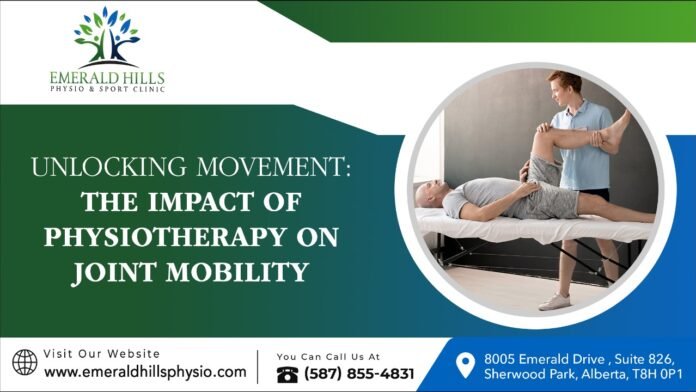Last Updated on July 16, 2024 by Asfa Rasheed
Joint mobility physiotherapy, also known simply as joint mobilization, addresses issues such as stiffness, pain, and restricted movement in the joints, which can be caused by various conditions, including injuries, arthritis, or surgical procedures. Physiotherapy in Sherwood Park aims to improve the range of motion, flexibility, and function of joints in the body.
Table of Contents
How Physiotherapy Can Help With Joint Mobility
Here are some key ways in which physiotherapy impacts joint mobility:
Joint Mobilization and Manipulation:
Physiotherapists mobilize and manipulate joints gently to improve their range of motion. These techniques help reduce joint stiffness, break down scar tissue, and restore normal movement patterns. Here are some common techniques used in joint mobility physiotherapy:
Passive Range of Motion (PROM):
Physiotherapists may perform passive movements on the joint, gently moving it through its range of motion without any active effort from the patient. PROM helps maintain joint mobility, prevent contractures, and reduce stiffness.
Active-Assisted Range of Motion (AAROM):
In AAROM, the patient actively participates in moving the joint with assistance from the physiotherapist. This technique is beneficial for individuals with limited mobility or muscle weakness, allowing them to gradually increase their range of motion with support.
Joint Mobilization:
Joint mobilization involves applying controlled, graded forces to the joint surfaces to improve mobility and restore normal joint mechanics. Physiotherapists use specialized tools to apply specific techniques, such as oscillations, gliding, traction, or distraction, depending on the joint and the individual’s condition.
Joint Manipulation:
Joint manipulation, also known as high-velocity low-amplitude (HVLA) thrust techniques, involves quick, precise movements applied to the joint to mobilize it beyond its passive range of motion. This technique aims to break down adhesions, release joint capsule restrictions, and improve joint mobility.
Muscle Energy Techniques (MET):
MET involves the active contraction of specific muscles around the joint while the physiotherapist applies a controlled counterforce. This technique helps improve joint mobility, correct muscle imbalances, and restore optimal alignment and function.
Soft Tissue Mobilization:
In addition to joint techniques, physiotherapists may address soft tissues, like muscles, ligaments, and tendons, to enhance joint mobility. Soft tissue mobilization techniques include massage, trigger point therapy, and the use of instruments for soft tissue mobilization.
Stretching and Flexibility Exercises:
Stretching exercises are essential for improving joint flexibility and reducing muscle tightness. Physiotherapists prescribe specific stretching routines targeting the muscles surrounding the affected joint to enhance its mobility gradually. Here are some common stretching and flexibility exercises used in joint mobility physiotherapy:
Static Stretching:
This involves holding a stretched position for a specific duration without movement. Physiotherapists prescribe static stretches targeting muscles around the affected joint to gradually increase flexibility. Examples include hamstring stretches, quadriceps stretches, calf stretches, hip flexor stretches, and shoulder stretches.
Dynamic Stretching:
This involves moving a joint through its range of motion in a controlled manner. Dynamic stretches help improve flexibility, mobility, and muscle activation before physical activity. Examples include leg swings, arm swings, hip circles, and trunk rotations.
PNF Stretching:
Proprioceptive Neuromuscular Facilitation (PNF) stretching techniques involve a combination of stretching and muscle contraction to enhance flexibility and range of motion. PNF techniques include hold-relax, contract-relax, and hold-relax with agonist contraction. Physiotherapists may use PNF stretching to target specific muscles around the joint effectively.
Strengthening Exercises:
Weak muscles can contribute to joint instability and limited mobility. Physiotherapists prescribe strengthening exercises to target specific muscle groups, improving joint stability and function. Strengthening exercises also help prevent future injuries and maintain long-term joint health. Here are some common strengthening exercises used in physiotherapy in Sherwood Park:
Isometric Exercises:
Isometric exercises involve contracting muscles without movement at the joint. These exercises help improve muscle strength and stability without placing excessive stress on the joint. Examples include quad sets (for knee strengthening), glute squeezes (for hip strengthening), and shoulder isometrics (for shoulder stability).
Isotonic Exercises:
Isotonic exercises involve muscle contractions with movement at the joint. Physiotherapists prescribe isotonic exercises to target specific muscle groups and improve joint function. Examples include squats, lunges, leg presses, calf raises (for lower limb strengthening), bicep curls, shoulder presses, and rows (for upper limb strengthening).
Eccentric Exercises:
Eccentric exercises involve lengthening the muscle under tension. Eccentric strengthening is particularly beneficial for improving muscle control, reducing muscle imbalances, and enhancing joint stability. Examples include eccentric hamstring curls, eccentric calf raises, and eccentric shoulder external rotation exercises.
Balance and Proprioception Exercises:
Balance and proprioception exercises help improve joint stability, body awareness, and neuromuscular control. These exercises are particularly beneficial for preventing falls and enhancing joint mobility in older adults or individuals with balance deficits. Examples include single-leg stance, balance board exercises, and proprioceptive drills.
Unlocking Potential:
Physiotherapy in Sherwood Park plays a pivotal role in improving the individual’s quality of life and experiencing limitations in joint function and mobility. Physiotherapy clinics provide a range of services to individuals seeking rehabilitation, injury prevention, pain management, and improved mobility and function. Emerald Hills Physiotherapy in Sherwood Park empowers individuals to participate in their rehabilitation journey, adopt strategies for self-management and foster sustainable improvements in joint mobility and quality of life. To experience these advantages firsthand, who can tailor a personalized therapy program to address your specific need, consider searching for a “physiotherapist near me,” and it will guide you on your path toward optimal health.
